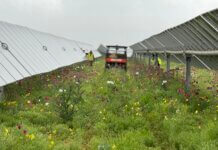As part of his 2018 State of the State, Gov. Andrew M. Cuomo, D-N.Y., has unveiled a comprehensive agenda to combat climate change by reducing greenhouse-gas (GHG) emissions and growing the clean energy economy. Notably, the agenda includes major commitments to solar power, energy storage, offshore wind, emissions reductions and energy efficiency.
According to a press release from the governor’s office, the 2018 Clean Energy Jobs and Climate Agenda will build on the progress made to date under Cuomo’s Reforming the Energy Vision (REV) policy, which includes the clean energy standard mandating that 50% of the state’s electricity needs come from renewable energy sources by 2030.
“New Yorkers know too well the devastation caused by climate change, and in order to slow the effects of extreme weather and build our communities to be stronger and more resilient, we must make significant investments in renewable energy,” states Cuomo. “With this proposal, New York is taking bold action to fight climate change and protect our environment while supporting and growing 21st-century jobs in these cutting-edge renewable industries.”
Solar
According to Cuomo, community solar, a REV initiative, is one of the best options for low-income customers to access solar and reduce their energy costs, but because community solar is relatively new and not yet widely adopted, low-income customers have yet to realize the program’s full potential. To help low-income New Yorkers reap the benefits of solar, the governor is announcing that the New York State Energy Research and Development Authority (NYSERDA) will do as follows:
- Use its purchasing power to secure community solar subscriptions for low-income customers and provide them at zero cost to deliver cost-savings and clean energy to more than 10,000 low-income New Yorkers; and
- Work with low-income energy efficiency programs, utilities, community agencies, solar project developers, investors and other stakeholders to market the program to low-income customers and develop strategies for how the program can better serve low-income New Yorkers and help them participate in the growing clean energy economy.
Sean Garren, Northeast senior director of advocacy group Vote Solar, says, “The governor’s Clean Energy Jobs and Climate Agenda continues New York on the path to a brighter, healthier future – and helps lead our nation in that direction, as well. We’re encouraged that the governor shares our own goal of a clean energy economy that supports all residents, including low-income and underserved communities, by offering bill savings, energy choices and job opportunities with solar.”
Garren adds, “Community solar is one of the state’s most promising opportunities to truly deliver clean energy access to all of New Yorkers. While the governor’s words of support are encouraging, real progress depends on the continued commitment and hard work of the Public Service Commission and NYSERDA to get us there. Vote Solar will continue to work with all stakeholders and push for community solar to succeed in 2018.”
Energy storage
Cuomo is also launching an initiative to deploy 1.5 GW of energy storage by 2025 and employ 30,000 New Yorkers in the industry. The commitment represents the largest such commitment per capita by any state, the governor claims.
Building on the recently signed Energy Storage Deployment legislation, Cuomo is directing state energy agencies and authorities to work together during 2018 to generate a pipeline of storage projects through utility procurements, advance regulatory changes in utility rates and wholesale energy markets, incorporate storage into criteria for large-scale renewable procurements, and reduce regulatory barriers.
The governor is also proposing a commitment of at least $200 million from NY Green Bank for storage-related investments to help drive down costs and strategically deploy energy storage to where the grid needs it most. Additionally, Cuomo is directing NYSERDA to invest at least $60 million through storage pilots and activities to reduce barriers to deploying energy storage, including permitting, customer acquisition, interconnection and financing costs. In addition to utility procurements and regulatory changes, these investments will be critical to jump-start the market and support cost-effective project development on the way to achieving the 1.5 GW goal, the governor says.
“NY-BEST applauds Governor Cuomo’s leadership in establishing a 1,500 MW target for energy storage by 2025 and for recognizing the crucial role that energy storage has in modernizing New York’s electric grid,” says Dr. William Acker, executive director of the New York Battery and Energy Storage Technology Consortium (NY-BEST). “Energy storage is critically important to providing real benefits for ratepayers, supporting widescale integration of renewable energy, reducing reliance on fossil-fueled power plants, providing grid resilience, and producing environmental and economic benefits for the state.”
Offshore wind
In the 2017 State of the State, Cuomo established a target of up to 2.4 GW of offshore wind by 2030. Now, he is calling for a procurement of at least 800 MW of offshore wind power between two solicitations to be issued in 2018 and 2019. These solicitations will be the first in a set schedule to reach the 2030 target.
In addition, Cuomo is directing NYSERDA to invest $15 million in workforce development and infrastructure advancement to train workers for jobs in offshore wind, including construction, installation, operation, maintenance, design and associated infrastructure.
To attract private investment in port infrastructure and supply-chain activities, he is further directing NYSERDA to work with Empire State Development and other state agencies to determine the most promising public and private offshore wind port infrastructure investments. According to Cuomo, these actions will jump-start project development, drive job growth and industry investments, and secure New York’s status as a home for the emerging U.S. offshore wind industry.
Emissions
In 2013, Cuomo led the nine Regional Greenhouse Gas Initiative (RGGI) states in reducing the cap on GHG emissions from power plants 50% by 2020. To further the efforts, the governor plans to work with the RGGI states and potential new partners in Virginia and New Jersey to ensure a smooth transition to a broader, more cost-efficient GHG market that maintains the initiative’s ambitious reductions in climate pollution.
Currently, RGGI covers only power plants with a capacity of 25 MW or greater, leaving out many smaller but highly polluting “peaking” units, which operate intermittently during periods of high electricity demand, the governor explains.
Consequently, Cuomo will direct the Department of Environmental Conservation (DEC) to do as follows:
- Undertake a rulemaking in 2018 to implement the 30% cap reduction of carbon dioxide to avoid nearly 133 million tons of additional carbon pollution region-wide from the electric power sector, as announced by the RGGI states in August 2017. This includes revisions to strengthen RGGI by grouping together and thereby covering peaking units that collectively exceed RGGI’s capacity threshold of 25 MW; and
- Work with NYSERDA to engage the Environmental Justice & Just Transition Working Group, convened by the governor in 2017, to ensure that Environmental Justice communities benefit equitably from investment of RGGI auction proceeds.
Moreover, in order to immediately reduce emissions from New York’s highest-polluting power plants, Cuomo is directing the DEC to propose complementary reforms to reduce emissions of smog-forming pollutants from peaking units and adopt regulations ending the use of coal in the state’s power plants by 2020 – what the governor called for in his 2016 State of the State address.
Climate change committee
After announcing its intention to withdraw from the Paris Agreement, the federal government also disbanded the Federal Advisory Committee for the Sustained National Climate Assessment, a group tasked with providing recommendations to the federal government on scientific information to support state and local governments, communities, and the private sector in planning for the effects of climate change, says Cuomo. However, the governor, in collaboration with partners, now plans to reconvene the advisory committee. In June 2017, Cuomo also formed the U.S. Climate Alliance with the governors of California and Washington State to ensure that New York and other partners continue to meet or exceed the targets of the Paris Agreement.
Energy efficiency
With more than 110,000 New Yorkers employed in energy-efficiency-related jobs, the industry is already a major component of New York’s clean energy economy, the governor says.
Building on the progress made through utility programs and work to reduce energy use in state facilities, Cuomo launched the $5 billion Clean Energy Fund in 2016 to support investment in energy efficient technologies.
However, much work remains to realize the full potential of energy efficiency for New Yorkers. To address this, Cuomo is directing the New York Department of Public Service and NYSERDA to engage the public and private sector and propose a comprehensive and far-reaching energy efficiency initiative by Earth Day on April 22, 2018; propose a new 2025 energy efficiency target achieved through cost-effective implementation strategies and innovative approaches from both utilities and the Clean Energy Fund; and identify opportunities by which state facilities can lead by example.
Applauding the governor’s agenda, Lisa Dix, senior New York representative for the Sierra Club’s Beyond Coal Campaign, says, “The governor has chosen to lean forward on climate change and renewable energy – setting him, and his administration, up to play a key leadership role on these issues nationally and internationally. Critically, the Clean Energy Jobs and Climate Agenda provides a path to ensure that the state no longer relies on dirty, dangerous and outdated coal-fired power through a commitment that ensures all such plants in the state will retire by 2020.
“This, in conjunction with an 800 MW offshore wind development plan, charts a clear course for the state, ensuring that New York leads where the federal government fails – crafting a visionary agenda to combat climate disruption with renewable energy while creating family-wage jobs alongside new economic development and manufacturing opportunities for New Yorkers.”




